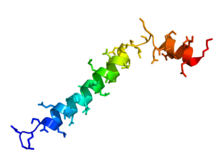Thymosin

Thymosins are small proteins present in many animal tissues. They are named thymosins because they were originally isolated from the
Discovery
The discovery of thymosins in the mid 1960s emerged from investigations of the role of the
When individual thymosins were isolated from Fraction 5 and characterized, they were found to have extremely varied and important biological properties. However they are not truly thymic hormones in that they are not restricted in occurrence to thymus and several are widely distributed throughout many different tissues.[4][5][6]
Doping in sports
Thymosin beta-4 was allegedly used by some players in various Australian football codes and is under investigation by the Australian Sports Anti-Doping Authority for anti-doping violations.[7][8]
Thymosin as a hair loss treatment
The process of hair growth utilizes many cellular and molecular mechanisms common to angiogenesis and wound healing. While studying the influence of thymosin beta-4 (Tβ4) on wound healing, Philp et al. accidentally found that hair grew more rapidly around the edges of wounds. In due course, they showed that Tβ4 induced rapid hair growth on the dorsal skin of healthy mice.[9]
See also
References
- Notes
- PMID 12852257.
- PMID 6087503.
- ^ "Thymus". EndocrineWeb. Retrieved June 24, 2022.
- ^ S2CID 3177237.
- ^ S2CID 222082792.
- S2CID 222082988.
- PMID 23084823.
- ^ https://theconversation.edu.au/cronulla-sharks-and-thymosin-beta-4-is-it-doping-12694 (Feb/Mar 2013)
- ^ "Triggering Hair Growth at a Cellular Level". 2017-04-16. Retrieved 2017-04-21.
- Sources
- Koh, B. (2013). Cronulla Sharks and thymosin beta-4 ... is it doping? Retrieved from http://theconversation.edu.au/cronulla-sharks-and-thymosin-beta-4-is-it-doping-12694
External links
- thymosin at the U.S. National Library of Medicine Medical Subject Headings (MeSH)
